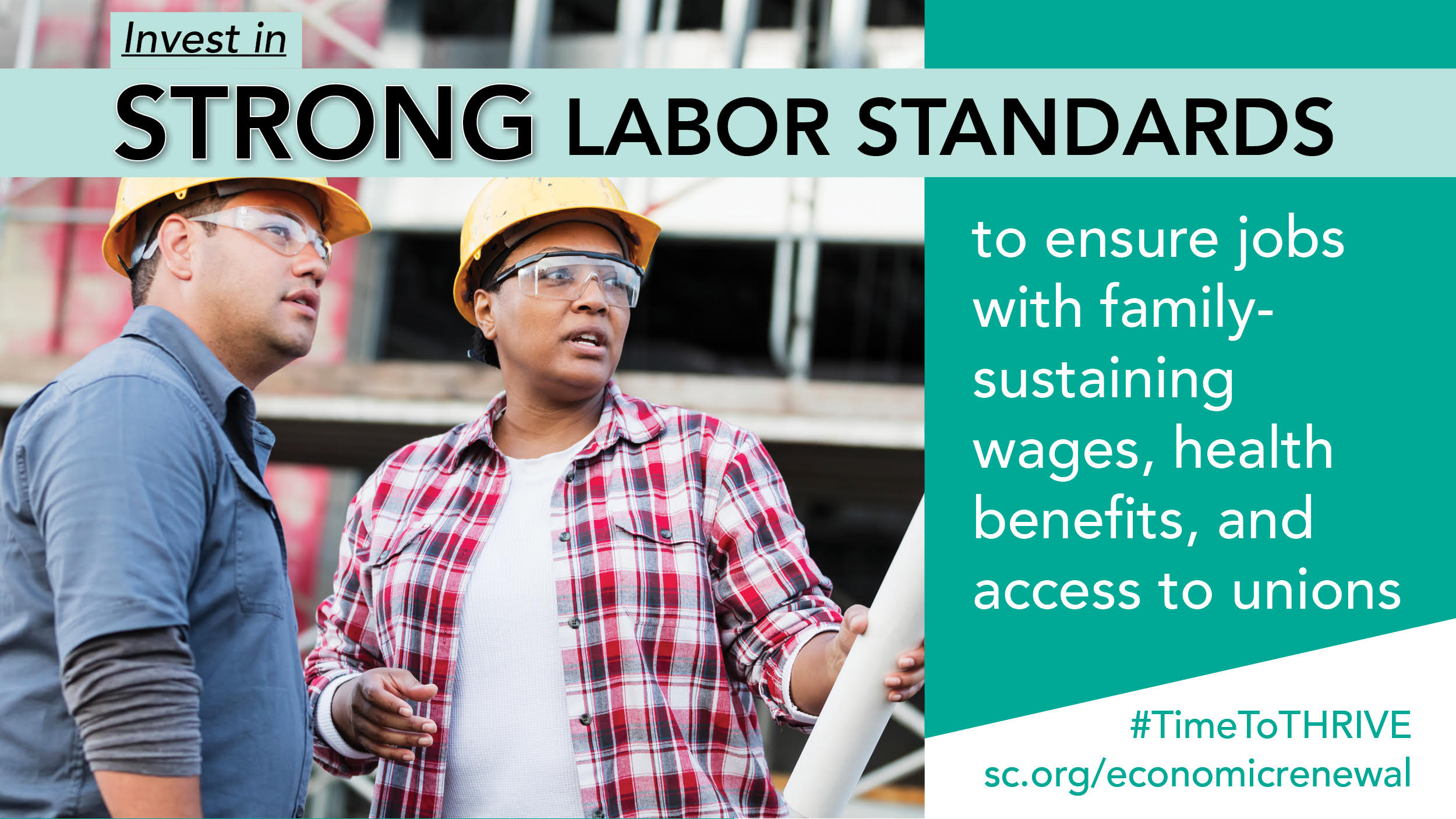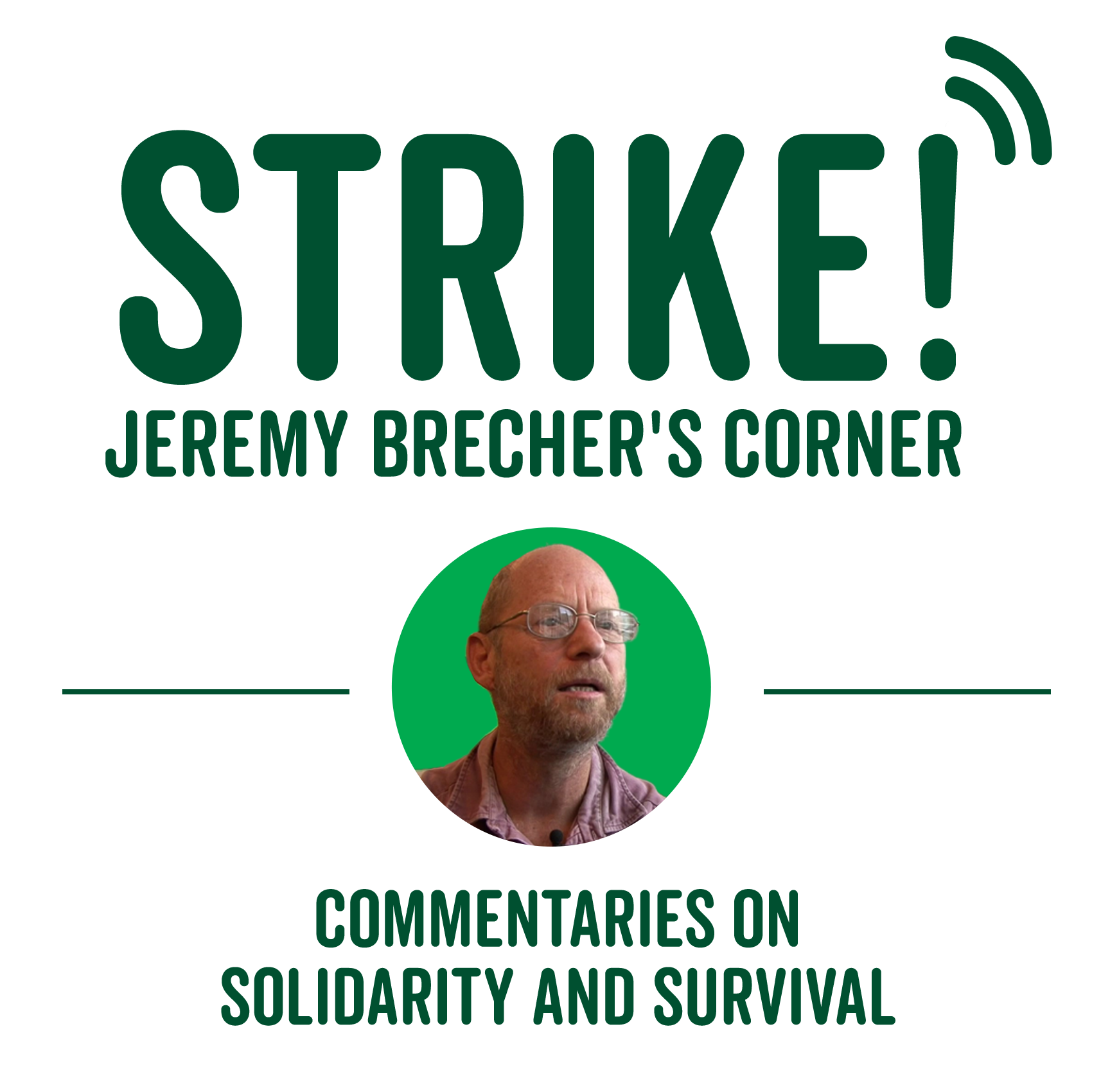Listen to the audio version >>
What can we learn from the role of people power in the Great Depression and in the first year of the Coronavirus Depression? Based on the seven preceding commentaries on the New Deal and the popular movements of 2020, this commentary maintains that popular direct action can play a significant role in shaping the Biden era. It examines the emerging political context and suggests guidelines for navigating the complex landscape that lies ahead.
While President Joe Biden has said he “believes the Green New Deal is a crucial framework for meeting the climate challenges we face,” he is not defined as this being his ultimate platform for economic recovery in the same way the New Deal was for President Franklin D. Roosevelt.
By many measures, the Coronavirus Depression is the worst since the Great Depression of the 1930s, but there are many important differences between the 1930s and today. Both the similarities and the differences affect the strategic landscape for social change. “People power” direct action played a significant role then as it does today, but the differences in context lead to differences in the nature of that role.
The Great Depression was one great national crisis that was widely perceived as including worker, farmer, environmental, and other dimensions within itself. Today we face at least five distinctive though deeply interpenetrating crises: climate, pandemic, depression, racial inequality and democracy.
The presidency of Franklin Roosevelt started with a historic electoral landslide that gave the Democratic Party control of both Senate and House. The President’s charismatic appeal to a desperate public gave room to introduce reforms that would have met massive opposition in more normal times. The Biden administration, in contrast, entered office with a Congress and a public deeply divided. But it is important to realize that in both cases, a powerful bloc including Southern racists, businesses, and the Supreme Court were skeptical of reforms proposed by the President. In the 1930s, these forces were eventually able to halt New Deal reforms; what will happen to current reform programs is likely to remain contested.
While the New Deal was an entire era of social reform involving many centers of power and initiative, there was no question that President Roosevelt was its leader and the principal shaper of its agenda. The broad program of the Green New Deal preceded Biden’s presidential campaign and has its own program and supporting forces. While Joe Biden has adopted many of its themes, he has eschewed calling his program the Green New Deal, referring to his own program instead as “Build Back Better.” This means that the Green New Deal is not being defined as the nation’s program in the way that Roosevelt defined the original New Deal. But this also creates the opportunity for the Green New Deal to serve as an independent confluence of forces that may be broadly supportive of Biden’s reforms but is also able to act as an independent force, appealing to the public for deeper change and working for implementation in both the political system and civil society.
As the Coronavirus pandemic spread across the U.S. in early 2020, more than 20 million people lost their jobs, creating the highest unemployment rate since the Great Depression.[1] Millions faced eviction and hunger. A large “stimulus package,” an eviction moratorium, and other public policies countered some of the worst effects, but by the end of 2020 such relief had shrunk to barely a pittance. As the pandemic grew worse, food lines, evictions, and unemployment soared. At the end of 2020 the U.S. Census Bureau found that 83 million adults –one in three–reported that in the past week it was somewhat or very difficult for their household to cover usual expenses such as food, rent or mortgage, car payments, medical expenses, or student loans; for Black and Latino adults it was nearly 50%. 12% of adults–nearly 26 million–said their household sometimes or often didn’t have enough to eat over the previous week.[2] Meanwhile more than 28 million Americans have been infected with COVID-19 and 500,000 have died.
The next phase of the Coronavirus Depression will be affected by the course of the pandemic, the actions of the Biden administration, and what Congress is willing to pass. That will depend on epidemiology, politics–and popular action.
The pandemic is also accelerating changes in America’s class structure. In the “recovery” from the Great Recession, the U.S. developed a low-wage workforce, concentrated in the service economy, that composed about 40% of the workforce.
A 2019 Brookings report shows that 53 million Americans—44% of all workers aged 18-64—had low-wage jobs, with median hourly wages of $10.22 and median annual earnings of $17,950.[3] Their work was normally contingent, part-time, and without benefits or job security. It included a high proportion of Black, Latino, female, immigrant, and young workers. Today hardship is concentrated in this same sector of the workforce. It includes the unemployed; those who want to work but aren’t looking for work; “essential workers” working at high risk for COVID-19 at low pay; and freelance, gig, and other contingent workers excluded from job security, unemployment compensation, and other benefits. COVID-era reduction in jobs and growth of contingent work are concentrated in particular sectors like tourism and entertainment. (In the Great Depression certain sectors–notably agriculture–similarly saw disproportionate and permanent shrinkage.) Meanwhile, the collective wealth of America’s 660 billionaires has increased by nearly 40%–over $1.1 trillion–since the start of the pandemic.[4]
While prediction is difficult, especially about the future, we can reasonably expect continuation of our five great crises; continuing hardship for at least 40% of the population; division and vacillation in the Biden administration and Congress; a continuing rightwing threat; and a potent Green New Deal coalition. This configuration makes it likely that people power action can exercise influence in the balance of forces.
Some Strategic Guidelines

The Sierra Club, which is part of the Green New Deal Network and an endorser of the THRIVE Agenda, is pushing for A Plan for Economic Renewal in order for the Biden administration to truly “Build Back Better.” This “THRIVE-aligned economic renewal plan would provide family-sustaining jobs for 15.5 million people for the next 10 years.” Source sc.org/economicrenewal.
What strategic lessons can we draw from the history of people power action in the Great Depression and the first year of the Coronavirus Depression for the new period we are entering? Here are some thoughts that may be useful for a variety of groups and constituencies, for their confluence, and for the development of the Green New Deal.
People power can work. While it is notoriously difficult for people who are suffering hardship as a result of “hard times” to organize themselves and take action, the history of people power shows it is possible to do so even under depression conditions. The pandemic presents additional barriers to effective action. But the fact that the largest protest in U.S. history–Black Lives Matter – took place at the height of the pandemic shows that these obstacles can be overcome.
Multiple crises require synergistic movements. American society is faced with multiple intersecting crises–climate, pandemic, depression, racism, and democracy, each of which is critical for the future of the others. While particular actions may address one or another, they should do so in a way that contributes to broader solutions that address them all. Supporting each other’s demands is the alternative to catastrophic division. If different sectors compete for funding, policy priorities, and public sympathy, they will simply play into the hands of those who would like to defeat them all. The Biden American Rescue Plan showed awareness of this trap; it tied together in one bill the interests of many critical constituencies. Republicans tried to defeat it by trying to force the Democrats to throw some of their constituencies overboard to lighten the price tag. Fortunately they failed.
Keep the public front and center. The purpose of people power action is not just to put pressure on Biden, Democrats, or even on Republicans, but to educate, mobilize, and inspire the people and to help them understand the problems and what needs to be done. This has been strikingly effective in the Coronavirus era. Action for safe schools and personal protective equipment dramatized the need for COVID policies that protect workers; actions demanding premium pay for essential workers dramatized the unfairness of low-wage work, laying the groundwork for $15 state and federal minimum wages; rent strikes made the eviction crisis visible and helped lead to the moratorium on evictions; Black Lives Matter put racial oppression at the center of national consciousness and politics. Much of the population feels that neither Republicans nor Democrats have the solution to their problems. People power action needs to define itself not in terms of Democrats vs. Republicans, but rather as an effort to address people’s desperate needs.
Use people power to create pressure for political response. For example, there is overwhelming popular support for stimulus payments and unemployment benefits, but there has yet to be large, visible public action for them. Senators are an obvious target for the kind of pressure from below –pioneered by the Tea Party and Indivisible–by those who face economic disaster without such assistance. And it can work. For example, late in 2020 unemployed workers with Step Up Louisiana used a wide range of pressure tactics to persuade Republican Sen. Bill Cassidy to support legislation that included $300 weekly unemployment benefits, contributing to the shift of Republican Senators to support an emergency relief package in December, 2020.[5]
Go local to go national. The Democratic control of the presidency and Congress puts national politics front and center as a target for popular action–attempting to affect federal policy is no longer the futile task it often appeared to be in the Trump era. But other arenas remain crucial. The policy of an employer, a school board, or a state agency can be a life-or-death matter for those it affects. These are among the many targets that can be directly affected by people power pressure. And the struggles to affect them can have a powerful demonstration effect on national politics–witness the local action of the unemployed in the 1930s and the impact of local action by teachers and nurses in 2020.
Make the Green New Deal an independent center for people power. The Green New Deal has emerged as a vehicle for a wide array of forces and programs that integrate the solutions to our overlapping crises. It has become a broad movement in the whole of society which includes local, state, and national action and forces in many parts of government and civil society. It should aim to transform the American people into an organized force for implementing its program through people power action.
Use conflict constructively. There undoubtedly will be times when popular movements will find themselves in conflict with the Biden administration and the Democratic Congress. This happened with the nascent industrial unions and the Roosevelt administration – by 1934 the New Deal’s National Recovery Administration (NRA) was being scorned by local union organizers as the “National Run-Around.” But the challenge is to fight in such a way as to push the overall Green New Deal project forward rather than undermining it.
Fight for both Build Back Better and the Green New Deal. Despite their differences, both of these programs will meet fierce opposition from the same forces–the Republican Party, the racists and fascists who form the hardcore support for Donald Trump, and the business forces who fear their wealth will be threatened by climate protection and economic redistribution. There will also be powerful forces within the Biden administration, the Democratic Party, and the Democratic caucus in Congress that, while giving lip service to Build Back Better, will be fighting fiercely to prevent the realization of climate protection and redistribution objectives. These will include fossil fuel Democrats, corporate “portfolio Democrats,” and military hawks seeking foreign adventures and global domination. Build Back Better and the Green New Deal, in short, will be less two opposed programs than one arena of overlapping struggles.
Make “Build Back Better”better. People ask: should movements support or oppose Biden’s program? It’s the wrong question! They should mobilize people to fight for what we all need.
Passage of Biden programs and expanding them when inadequate are not incompatible objectives. The goal should be not to block but to improve and expand “Build Back Better” initiatives. A crucial means to do so is to develop more radical Green New Deal programs – and transform Biden’s “Build Back Better” program into the vision of the Green New Deal.
President Roosevelt turned to the most radical program of social reform since the Civil War–often referred to as the “Second New Deal”–because, as one old New Dealer once explained to me, he had to keep ahead of all of the rival forces articulating popular interests or lose his own base. There is an opportunity for people power and the Green New Deal to establish a similar dynamic today. In fact, the opportunity may be greater: Roosevelt could count on his electoral success and his ability to appeal to the people, but Biden can’t depend on either clout or charisma in the same way. He already seems to be acting on an understanding that he has to maintain leadership of the movement for reform or lose his base to his rivals.
This gives those who want deeper change a strong hand, but it is a hand that it would be dangerous to overplay. For the success of both Build Back Better and the Green New Deal it is essential to strengthen Biden’s support against very powerful Republican and fascist forces. A delicate balance is necessary to simultaneously undermine those forces while both strengthening the Build Back Better forces and also radicalizing them.
The New Deal didn’t fix the Depression. After its most dynamic phase the New Deal was halted and rolled back. It is often said the New Deal saved American capitalism. A similar fate could meet Biden’s Build Back Better reforms–or even the Green New Deal. We should envision not only a “Second Green New Deal,” but a third, fourth, and perhaps still further ones. People power can be a crucial force in driving the process forward.
As in the Great Depression, people power in the Coronavirus Depression has not been the result of a grand scheme. Rather, it has come as a series of responses to terrible and in many cases life threatening conditions. While we can improve our future action by learning lessons from our past, future people power action is likely to be more a response to the problems people face than the result of any master plan. Nonetheless, people can learn from their own and each other’s past experience and they can join together to pool their knowledge and their power. When they do, their action can make a critical difference––perhaps even the critical difference.
The crises we face are too important and too desperate to leave to politicians and experts. They require intervention by the people who are suffering from them. If those who are in hardship are silent, no one else is likely to pay much attention to their suffering. People in need must speak for themselves, act, and be heard. As former Secretary of Labor Robert Reich recently wrote, updating Black abolitionist Fredrick Douglass’ remark that “Power never conceded without a demand,”
The responsibility for summoning the political will to reverse inequality will fall to lower-income Americans of whatever race, progressives and their political allies. They will need to organize, mobilize and put sufficient pressure on Biden and other elected leaders to act. As it was in the time of FDR and LBJ, power is redistributed only when those without it demand it.”[6]
[1] Stephanie Soucheray, “US job losses due to COVID-19 highest since Great Depression,” CIDRAP News. May 8, 2020. https://www.cidrap.umn.edu/news-perspective/2020/05/us-job-losses-due-covid-19-highest-great-depression
[2] Census Pulse data drawn from “Tracking the COVID-19 Recession’s Effects on Food, Housing, and Employment Hardships,” Center on Budget and Policy Priorities, December 2, 2020.
[3] Martha Ross and Nicole Bateman, “Meet the low-wage workforce,” Brookings, November 7, 2019. https://www.brookings.edu/research/meet-the-low-wage-workforce/
[4] Chuck Collins, “660 Billionaires See Wealth Rise 40 percent,” Portside, January 29, 2021. https://portside.org/2021-01-29/660-billionaires-see-wealth-rise-40-percent
[5] Step Up Louisiana, https://www.stepuplouisiana.org. “Unemployed Workers ‘The Bills Don’t Stop Rally’ Thursday,” The Big Easy Magazine, December 9, 2020. https://www.bigeasymagazine.com/2020/12/10/unemployed-workers-the-bills-dont-stop-rally-thursday/
[6] Robert Reich, “Joe Biden’s economic team beats Trump’s goon squad – but it faces a steep challenge,” The Guardian, December 6, 2020. https://www.theguardian.com/commentisfree/2020/dec/06/joe-biden-economic-team-trump-robert-reich

